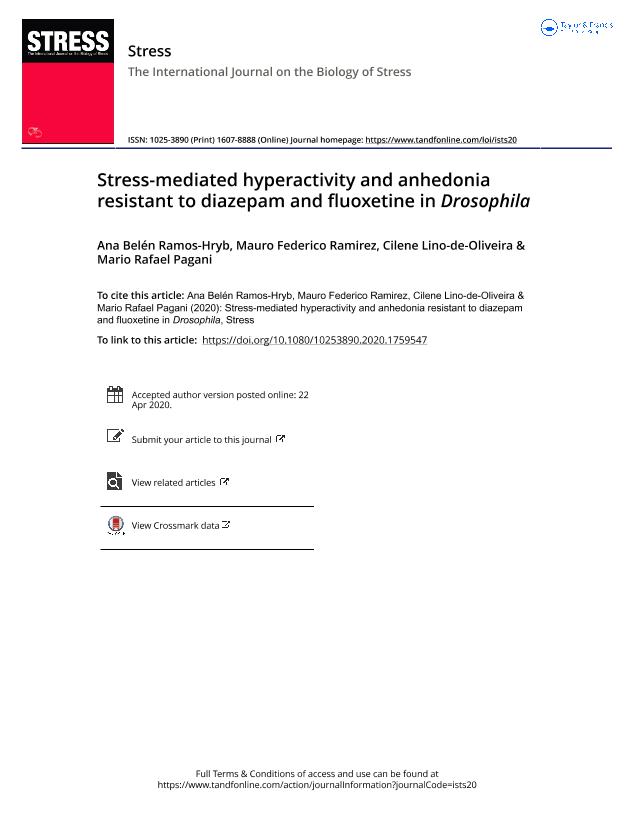Mostrar el registro sencillo del ítem
dc.contributor.author
Ramos Hryb, Ana Belen

dc.contributor.author
Ramirez, Mauro Federico
dc.contributor.author
Lino de Oliveira, Cilene
dc.contributor.author
Pagani, Mario Rafael

dc.date.available
2021-09-20T11:50:43Z
dc.date.issued
2020-05
dc.identifier.citation
Ramos Hryb, Ana Belen; Ramirez, Mauro Federico; Lino de Oliveira, Cilene; Pagani, Mario Rafael; Stress-mediated hyperactivity and anhedonia resistant to diazepam and fluoxetine in Drosophila; Taylor & Francis Ltd; Stress; 24; 1; 5-2020; 96-106
dc.identifier.issn
1025-3890
dc.identifier.uri
http://hdl.handle.net/11336/140810
dc.description.abstract
Distresses may induce behavioral phenotypes constituting heuristic models for psychopharmacology studies. In several species, including Drosophila, antidepressants counteract stress-induced phenotypes allowing the use of these models to test new psychoactive drugs. Here, we developed a novel and time-efficient protocol to provoke stress-induced phenotypes in Drosophila for the study of psychopharmacological agents. In the first experiment, flies (n = 12/groups) were exposed to a random-sequence of different types of stresses during nearly 24 h (including social isolation, fasting, heat, and electric shock), a protocol named short-term variable stress (SVS). Second, flies were exposed to a single stressful stimulus (social isolation, fasting, heat shock or electric shock, n = 12/groups). Next, flies submitted to SVS protocol were treated with vehicle, diazepam or fluoxetine (n = 12/groups). At the end of the stress protocols, behavioral phenotypes were evaluated in the open field (OF) and sucrose preference tests. In comparison to the unstressed group, flies exposed to SVS exhibited hyperactivity, as well as shorter times exploring the boundaries of the OF. In contrast to fasting stress, SVS reduced sucrose preference in flies. By analyzing the effects of individual stimuli on fly behavior, fasting and electric shock appear to be the predominant influences on the SVS-induced behaviors. Although fluoxetine or diazepam reduced the initial locomotor activity of flies, no treatment prevented the sequelae of SVS. Altogether, this study provides a time-efficient model system for the study of stress-mediated hyperactivity and anhedonia-like state resistant to fluoxetine and diazepam. The applications of SVS in Drosophila to preclinical psychopharmacology require further studies.LAY SUMMARY Exposition to unpredictable stress plays a significant role in psychiatric disorder’s onset. Behavioral traits of these disorders can be partially modeled in rodents aimed at developing psychopharmacological therapies. However, studies in rodents were questioned by ethical issues. Focused on 3Rs principles, we developed a preclinical model for stress and psychopharmacology research in Drosophila. Variable stress induced behavioral alterations, including hyperlocomotion and reduced preference for sucrose in flies. However, behavioral alterations were resistant to fluoxetine and diazepam.
dc.format
application/pdf
dc.language.iso
eng
dc.publisher
Taylor & Francis Ltd

dc.rights
info:eu-repo/semantics/openAccess
dc.rights.uri
https://creativecommons.org/licenses/by-nc-sa/2.5/ar/
dc.subject
ANTIDEPRESSANTS
dc.subject
ANXIOLYTICS
dc.subject
CHRONIC UNPREDICTABLE STRESS
dc.subject
DROSOPHILA
dc.subject
PRECLINICAL TEST
dc.subject
PSYCHOPHARMACOLOGY
dc.subject.classification
Otros Tópicos Biológicos

dc.subject.classification
Ciencias Biológicas

dc.subject.classification
CIENCIAS NATURALES Y EXACTAS

dc.title
Stress-mediated hyperactivity and anhedonia resistant to diazepam and fluoxetine in Drosophila
dc.type
info:eu-repo/semantics/article
dc.type
info:ar-repo/semantics/artículo
dc.type
info:eu-repo/semantics/publishedVersion
dc.date.updated
2021-09-07T18:57:04Z
dc.journal.volume
24
dc.journal.number
1
dc.journal.pagination
96-106
dc.journal.pais
Reino Unido

dc.journal.ciudad
Londres
dc.description.fil
Fil: Ramos Hryb, Ana Belen. Consejo Nacional de Investigaciones Científicas y Técnicas. Oficina de Coordinación Administrativa Houssay. Instituto de Fisiología y Biofísica Bernardo Houssay. Universidad de Buenos Aires. Facultad de Medicina. Instituto de Fisiología y Biofísica Bernardo Houssay; Argentina
dc.description.fil
Fil: Ramirez, Mauro Federico. Consejo Nacional de Investigaciones Científicas y Técnicas. Oficina de Coordinación Administrativa Houssay. Instituto de Fisiología y Biofísica Bernardo Houssay. Universidad de Buenos Aires. Facultad de Medicina. Instituto de Fisiología y Biofísica Bernardo Houssay; Argentina
dc.description.fil
Fil: Lino de Oliveira, Cilene. Universidade Federal de Santa Catarina; Brasil
dc.description.fil
Fil: Pagani, Mario Rafael. Consejo Nacional de Investigaciones Científicas y Técnicas. Oficina de Coordinación Administrativa Houssay. Instituto de Fisiología y Biofísica Bernardo Houssay. Universidad de Buenos Aires. Facultad de Medicina. Instituto de Fisiología y Biofísica Bernardo Houssay; Argentina
dc.journal.title
Stress

dc.relation.alternativeid
info:eu-repo/semantics/altIdentifier/url/https://www.tandfonline.com/doi/full/10.1080/10253890.2020.1759547
dc.relation.alternativeid
info:eu-repo/semantics/altIdentifier/doi/http://dx.doi.org/10.1080/10253890.2020.1759547
Archivos asociados
